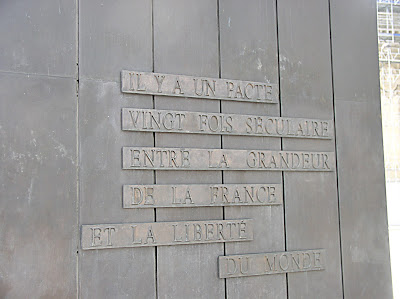The Champs-Elysées is 1.2 miles long and is the most beautiful and well-known avenue in Paris. It connects the Arc de Triomphe with the Place de la Concorde and is considered one of the world’s most famous commercial streets. It is also the site of the largest military parade in Europe, which is held every year on Bastille Day (July 14).
The Champs-Elysées-Clémenceau is a métro station within a few minutes walk from both the Grand Palais and the Petit Palais in the 8th arrondissement of Paris.
Sculpture of de Gaulle with a quadriga in the background
Charles de Gaulle was a French army officer and statesman who led Free France against Nazi Germany in World War II. He was later elected President of France and remained a controversial figure throughout his career. In the novel (1971) and movie, The Day of the Jackal, a professional assassin was hired to assassinate de Gaulle. This attempt was based on an actual but failed attempt on de Gaulle’s life.
Inscription on base of sculpture
“There is a linkage, twenty centuries old, between the grandeur of France and the liberty of the world.” [Charles de Gaulle, March 1, 1941]
Quadriga on Grand Palais
The quadriga, titled Immortality Outstripping Time (sometimes known as “Galloping Horses,”) is a magnificent structure which is meant to represent victory. It is typically shown as a chariot powered by four horses and driven by a Greek or Roman figure.
The Grand Palais is a large exhibition hall whose construction began in 1897 as part of the World’s Fair of 1900. Right now the Grand Palais is undergoing renovation, so it is completely covered in scaffolding.
Avenue des Champs-Elysées (Elysian Fields, the place for dead heroes in Greek mythology)
Look right and see the obelisk on the Place de la Concorde
Look left and see (half of) the Arc de Triomphe in the distance
Signs marking Place Clémenceau & the Petit Palais
Clémenceau sculpture
Georges Clémenceau, nicknamed “The Tiger,” (1841-1929), was a statesman and journalist who was a dominant figure in the French Third Republic. As premier (1917–20), he was a major contributor to the Allied victory in World War I and a framer of the postwar Treaty of Versailles.
Clémenceau marker
Jardin Clémenceau & Petit Palais in the background
Jardin Clémenceau
Jardin Clémenceau & Basin
Jardin & Bouquet of Tulips
In November, 2015, mass shootings and a bomb attack killed 130 people in Paris.
The co-ordinated terror attacks on a concert hall, a major stadium, restaurants and bars in the French capital wounded hundreds more. Unveiling his 40ft (12m) high structure near Le Petit Palais on Friday, Jeff Koons, American artist, said the large handheld bouquet of balloon-like tulips was intended to show his support and US solidarity with the French people
Bouquet of Tulips
Jeff Koons marker
"I did, as a citizen in New York, experience 9/11 and the depression that hung over the city," he said, adding that 80% of the money raised after selling the copyright to the artwork would be given to the victims' families.
Bouquet of Tulips
The hand clutches a spray of flowers that are supposed to look as though they were fashioned from balloons. It is 40 feet tall and modeled on the Statue of Liberty. The bouquet features eleven flowers and not a dozen, with the missing twelfth meant to represent the victims.
View of Bouquet of Tulips against the sky
Marker for dedication of the Bouquet of Tulips
Paris Mayor Anne Hidalgo said on Friday, October 4, 2019, that she was very happy to unveil the work, calling it a "beautiful gift" and "a magnificent symbol of freedom and friendship".

Bouquet of Tulips with the Petit Palais in the background.
Since the Bouquet of Tulips was made public, Parisians and critics have been sharing their thoughts, with some referring to the piece as "awful", "grotesque" and "pornographic". Others, though, said they did not understand the controversy, describing the work as "pretty" and "a gift from the heart". I thought it was beautiful although I didn’t right away see the connection between a bouquet of tulips and a monument to the victims of terrorist attacks. In the end, it is Jeff Koonts’s thought that counts.
I went to the Petit Palais specifically to see this art installation. It wasn’t easy to find, since it is in a lovely, large garden that is directly BEHIND the Petit Palais. Who goes there? Not many people, unless they are looking specifically for this artwork. Although its present setting is very lovely, it is too bad that it doesn’t have a more prominent location, especially since the American artist, Jeff Koons, meant it to be a statement of solidarity between France and the US.





















No comments:
Post a Comment